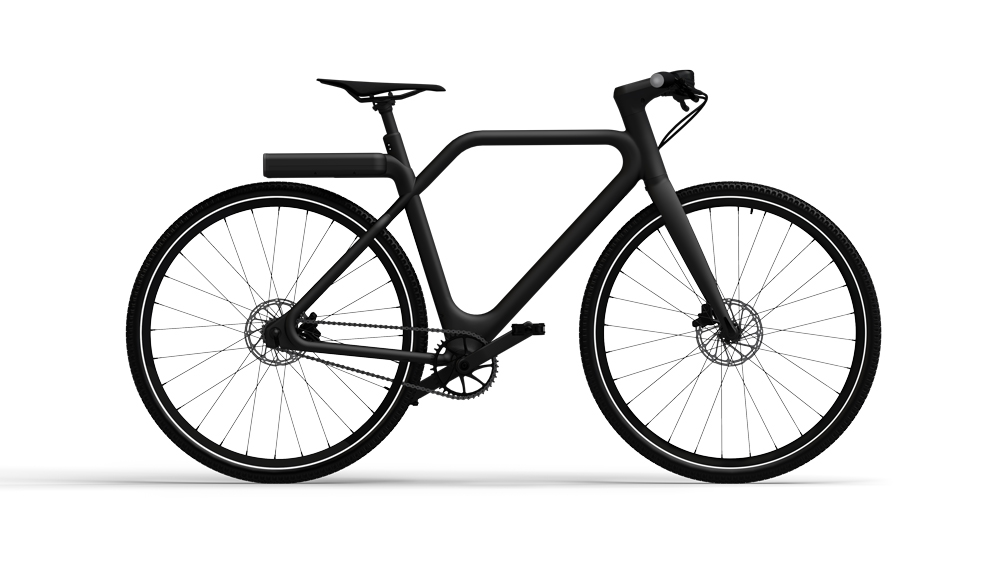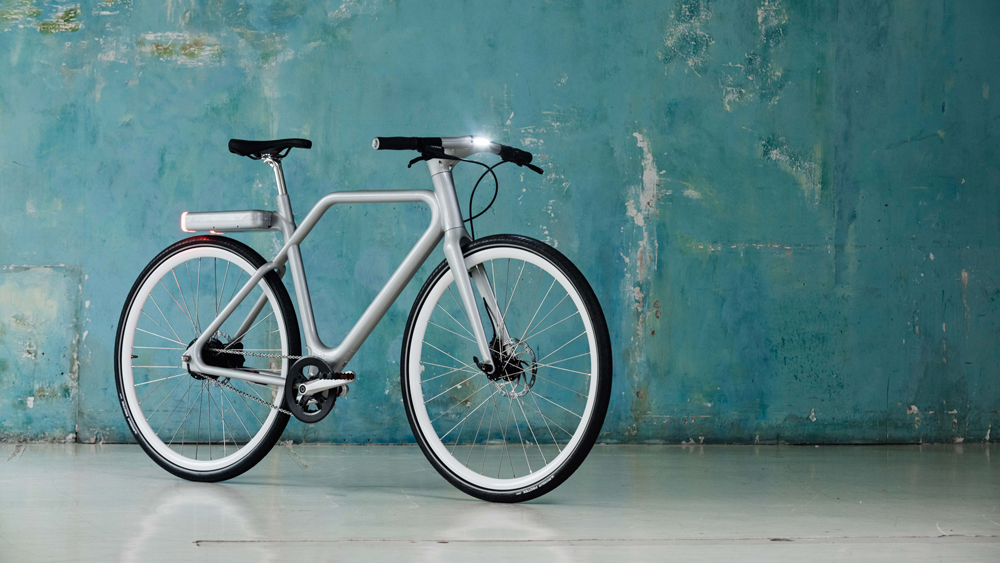You can trust Coach
Sure, bikes are great, but a growing number of start-ups think they can improve them as a means of urban travel by adding tech to the equation. Companies like Van Moof and Cowboy sell smart electric bikes equipped with GPS chips, and companion smartphone apps unlock the bikes and control features. One-upping them all is French start-up Angell, which has done the most 21st-century thing possible and stuck a screen in the middle of the handlebars.
The most useful feature of that screen is turn-by-turn navigation. Set a destination in the app and detailed directions will display on the screen. Since keeping your eyes on the road is advisable, the handlebars also buzz on either side – briefly as you approach a turn, and for longer as you are supposed to turn.
It’s a great idea and, although I was sceptical of its ability to route me around London, it worked better than I expected. It found addresses I searched for quickly and offered reasonable route options.
However, in what would become a recurring theme, the software could get a little buggy. On one occasion the GPS didn’t kick in automatically and the directions froze for an entire 45-minute ride. Predictions and readings of route distances and times could get a little wonky, too. A ride of 8km which always takes me in the region of 15 minutes was tracked as 24km and two hours 58 minutes. These issues seemed to have resolved themselves the next time the bike was turned on.
The directions are presented as arrows indicating the direction of the next turn, the distance to the turn and street name. Unfortunately that design isn’t well suited to London because street signs are often hidden or non-existent, although it probably makes more sense in Paris where Angell heralds from. I would have much preferred a satnav-style first-person view.
Even though it didn’t match up to a combo of bike phone holder and routing app like Komoot, I have to give Angell kudos for developing and implementing the idea. The screen is easy to read and responsive, and everything about it suggests it will be a feature to make future generations of the Angell e-bike worth buying.
There’s one other innovation that deserves plaudits, and that’s the removable battery which doubles as rear, brake and indicator lights. There are two discreet buttons by the left grip to operate the indicators, and a second set of indicator lights on the ends of the handlebars. The indicators also turn off automatically after you turn. It’s well done, although since it’s such a rare feature (the only other model I’ve seen with indicators is the Wau e-bike) I found it hard to remember to use it. Since other road users also probably aren’t expecting bikes to have indicators I also used hand signals even when I did switch the indicators on.
A post shared by Angell (@angell.bike)
A photo posted by on
There are other smart features of note, such as automatic accident detection, which will notify a preset contact if it detects a crash but also gives you a chance to cancel a notification being sent. A good thing too because when I lifted the bike up onto one wheel to manoeuvre it along a tight side passage it triggered the feature.
You can sync Apple Music or Spotify and control what the app on your phone is playing through the screen, although again my attempt to test this was stymied by the buggy software. The Bluetooth connection between my phone and the bike was poor, frequently dropping in and out. It resolved itself when I put away my Bluetooth headphones, although I did find I could use the bike, phone and headphones simultaneously on another occasion.
The bike is also turned on using the app and you can give other people permission to turn your bike on if they set up their own profile on the Angell app. As long as you have your phone on you, the Angell recognises it and brings up your user profile on the screen. Press it and the bike is activated and ready to go (you also set a PIN when connecting the bike to your app account so you can still use it without your phone). Walk away and the bike locks itself. The battery, on the other hand, has an old-fashioned key lock and slides out so you can take it with you and charge it.
There’s an alarm, but even if the bike is stolen the GPS chip means you can find out where it is. Competitors VanMoof and Cowboy have embedded GPS chips but security features and a retrieval service cost extra on those. The last time I checked these prices were broadly similar to e-bike insurance premiums, so it’s good to see Angell including this feature as a matter of course. You will have to use the police as your retrieval service, though.
See related
- The Best Electric Bikes For Commuting
- Electric Bike Buyers’ Guide
- Save £££s On An E-Bike Using The Cycle To Work Scheme

That’s a lot of smart and useful ideas. While the actual experience is still a bit frustrating, the potential is plain to see and really quite exciting. But of course all these additions are undermined if riding the bike isn’t up to snuff – the area where traditional bike companies tend to blow start-ups out of the water.
Most of the time the Angell was pleasant to ride, and the assistance kicked in smoothly and early once you started pedalling. All three levels of assistance make cycling a breeze and the kick on the highest level took me by surprise the first time I used it and the front wheel lifted up slightly.
However, I wish Angell had included gears. Around and over 15.5mph, when the assistance cuts out by UK law, I found so little resistance when pedalling that my cadence was comical. While the optimum resistance while you pedal will depend on the rider, not being able to adjust it at all is going to present a problem for some. If you suspect you might be in that group, there are a couple of Angell ambassadors in London who will let you test ride their Angell for free. Still, the most important thing is that you can get the 15.9kg bike moving easily and reach that top speed swiftly.
I certainly found it better to ride than the VanMoof, which felt heavier (it is 19kg) and whose automatic gear changes weren’t as smooth as I’d like. The Cowboy e-bike I tried was superior because I could push past 15.5mph if I wished – the assistance wasn’t applied as smoothly as on the Angell, although the latest generation of Cowboy may have improved that.
The range of the Angell’s battery is also impressive for the weight and price of the bike. The quoted range is 70km, and since the lightest level of assistance still requires little effort I’d say it even outperforms bikes that quote the same distance but oblige you to use a level of assistance that may cause you to sweat a little.
The battery also recharges in two hours, although be prepared to wait a while if you reattach the battery after running it right down because there’s an onboard bike battery, which will need five to 15 minutes to recharge itself.
The Angell costs £2,690 and it can be paid off in monthly instalments over a year through Splittit. There’s also an Angell /S, available for pre-order, which is £200 cheaper. It has a slightly smaller frame but is still said to be appropriate for people up to 185cm tall.
That makes the Angell more expensive than the VanMoof, which comes in under £2,000, and the Cowboy, whose third generation is also under £2,000 with the forthcoming version costing £2,290.
Angell doesn’t include accessories either, with mudguards (£89), a kickstand (£19.99), front rack (£79.99) and a front carrier (£119) all offered separately. VanMoof and Cowboy e-bikes at least come with mudguards as standard.
If the Angell’s software worked smoothly and reliably, I’d say the bike was worth the extra money if controlling it with your phone is something that appeals. For now, though, I’d recommend buying an e-bike from a bike manufacturer, like Specialized’s Vado SL or Ribble’s AL e hybrid and off-road CGR AL e, or Brompton’s e-bike if storage is an issue. You’ll spend more time riding and less time looking at a screen, and who doesn’t need that in the 21st century?
Buy from Angell | £2,690

Jonathan Shannon was the editor of the Coach website from 2016 to 2024, developing a wide-ranging experience of health and fitness. Jonathan took up running while editing Coach and used the training plans on the site to run a sub-40min 10K, 1hr 28min half marathon and 3hr 6min marathon. He’s an advocate of cycling to work and is Coach’s e-bike reviewer, and not just because he lives up a bit of a hill. He also reviews fitness trackers and other workout gear.

